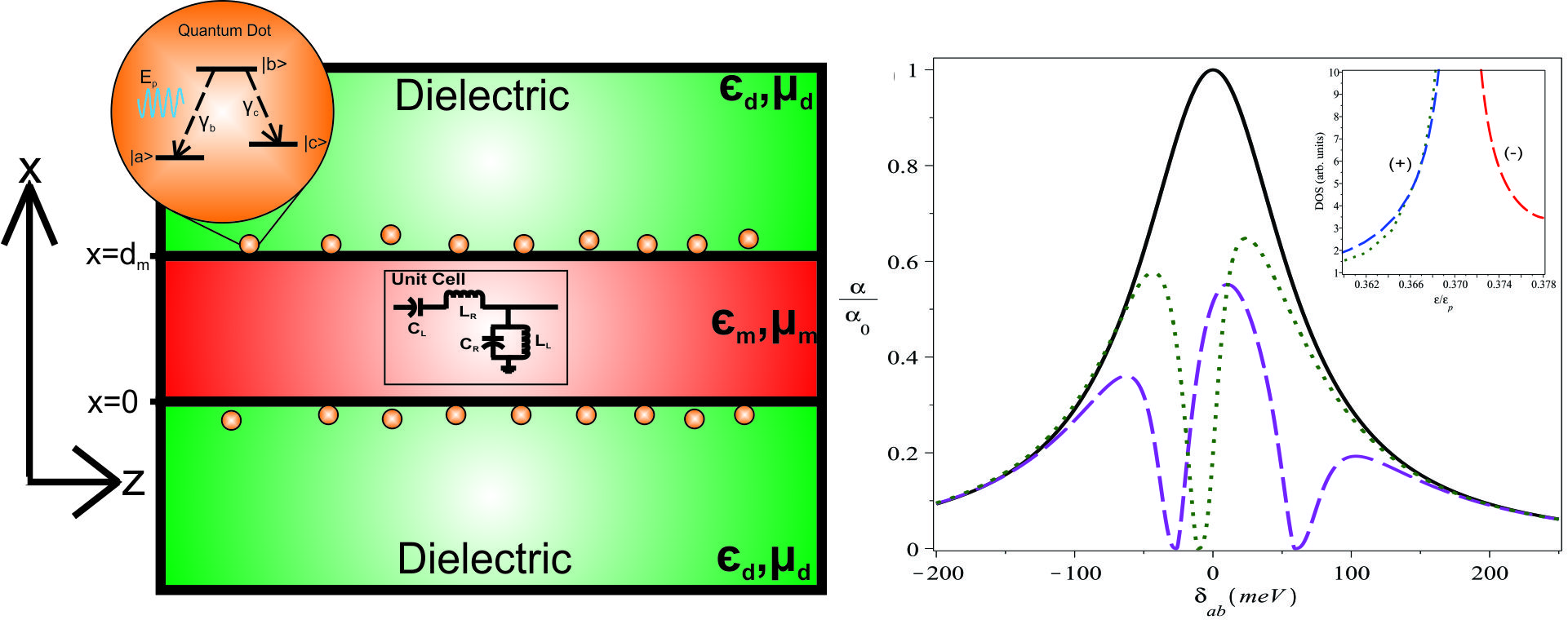

Metamaterials are a new class of artificial materials whose optical properties are determined not only by their classical atomic composition, but also by the nanoscale organization of their structural components. As a result, metamaterials possess unique electromagnetic properties which cannot be obtained from naturally occurring materials. Metamaterials have the dielectric permittivity and magnetic permeability simultaneously negative for a range of frequencies in the electromagnetic spectrum, effectively leading to a negative refractive index. Recently metamaterials based on periodic arrangements of metallic nanocomposites have rec eived special attention because they can be engineered to possess negative electric permittivity and magnetic permeability and their unit cells is much smaller than the operating wavelengths. It is well-known that the negative value of the electric permittivity in noble metals leads to the formation of surface plasmons which may generate exceptionally strong localized electromagnetic fields. This phenomenon has been exploited for many applications such as energy transfer, photoluminescence quenching, surface-enhanced Raman spectroscopy and some optoelectronic devices by using hybridsystems consisting of semiconductor and metallic nanoparticles . Therefore, metamaterials can also be combined with semiconductor nanoparticles to produce optical effects that are useful for developing advanced sensing and imaging devices, plasmonic data processing circuits and optical cloaking devices.
eived special attention because they can be engineered to possess negative electric permittivity and magnetic permeability and their unit cells is much smaller than the operating wavelengths. It is well-known that the negative value of the electric permittivity in noble metals leads to the formation of surface plasmons which may generate exceptionally strong localized electromagnetic fields. This phenomenon has been exploited for many applications such as energy transfer, photoluminescence quenching, surface-enhanced Raman spectroscopy and some optoelectronic devices by using hybridsystems consisting of semiconductor and metallic nanoparticles . Therefore, metamaterials can also be combined with semiconductor nanoparticles to produce optical effects that are useful for developing advanced sensing and imaging devices, plasmonic data processing circuits and optical cloaking devices.
In nanostructured metamaterials, metallic Joule losses are the main obstacle in achieving optical negative index media and narrow resonance frequency selective surfaces for photonic applications. Therefore the control of Joule losses is one of the challenges for metamaterial technologies. Losses hamper the development of devices made from metamaterials. Many methods have been suggested to overcome these losses including using gain media and parametric processes. For example it has been suggested that through the local-field amplification mechanism a very small amount of gain can strongly change absorption and transmission of certain metamaterials. This method can be used to create conditions for a metamaterial lasing device called "lasing spaser" which is nothing but a metamaterial version of the spaser. Lowering losses is also crucially important for the performance of spectral filters, delay lines and, in fact, practically any other metamaterial and plasmonic application. Recently there have been efforts to compensate plasmonic losses in metamaterials by combining them with optically active media such as semiconductor quantum dots.
We study photoluminescence and spontaneous emission in quantum dots doped in a dielectric substrate-metamaterial heterostructure. A schematic diagram of the heterostructure is shown in Fig. 1. The heterostructure is formed by fabricating a split-ring resonator and metallic rod metamaterial on a dielectric substrate. Quantum dots are doped near the interface in the heterostructure. Our results indicate that the photoluminescence and spontaneous emission of the QDs are enhanced in the presence of the metamaterial when the exciton and surface plasmon frequencies are resonant. These findings are consistent with recent experimental studies. The present study can be used to make new types of optical devices for sensing, switching and imaging applications based on metamaterials.
substrate-metamaterial heterostructure. A schematic diagram of the heterostructure is shown in Fig. 1. The heterostructure is formed by fabricating a split-ring resonator and metallic rod metamaterial on a dielectric substrate. Quantum dots are doped near the interface in the heterostructure. Our results indicate that the photoluminescence and spontaneous emission of the QDs are enhanced in the presence of the metamaterial when the exciton and surface plasmon frequencies are resonant. These findings are consistent with recent experimental studies. The present study can be used to make new types of optical devices for sensing, switching and imaging applications based on metamaterials.
The effect of surface plasmon polaritons on the absorption coefficient of quantum dots in metamaterial waveguides is studied (see figure). The waveguides are made by sandwiching a metamaterial between two dielectric material layers. An ensemble of lambda configuration, three-level quantum dots are deposited near the waveguide interfaces. It is found that when the thickness of the waveguide is of the order of the wavelength of the interaction light, the surface plasmon polariton energy states are split. Excitons of the quantum dot are interacting with surface plasmon polaritons of the waveguide, which is acting as reservoir. The Schrodinger equation method has been used to calculate the absorption coefficient for the three-level quantum dot. It is observed that when the exciton resonance frequency lies near the surface plasmon polariton frequencies of the waveguide we get transparent states in the absorption spectrum. This effect is due to strong coupling between excitons and surface plasmon polaritons. However, when the excitons energy do not lie near the surface plasmon polariton frequencies, all the transparent states disappears due to weak coupling. The present study can be used to make new types of optical devices for sensing and imaging applications based on metamaterials.